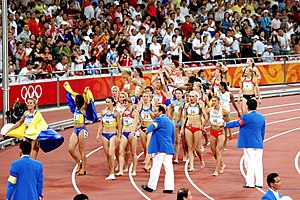Women's heptathlon
|
Athletics Heptathlon |
|
|---|---|

Heptathletes at Beijing 2008
|
|
| Women's records | |
| World | Jackie Joyner-Kersee 7291 pts (1988) |
| Olympic | Jackie Joyner-Kersee 7291 pts (1988) |
A heptathlon is a track and field combined events contest made up of seven events. The name derives from the Greek hepta (seven) and ἄθλος (áthlos, or ἄθλον, áthlon, meaning "feat"). A competitor in a heptathlon is referred to as a heptathlete.
There are two heptathlons – the women's heptathlon and the men's – composed of different events. The men's heptathlon is older and is held indoors, while the women's is held outdoors and was introduced in the 1980s, first appearing in the Olympics in 1984.
Women's heptathlon is the combined event for women contested in the Athletics program of the Olympics and in the IAAF World Championships in Athletics. The IAAF World Combined Events Challenge determines a yearly women's heptathlon champion. The women's outdoor heptathlon consists of the following events, with the first four contested on the first day, and the remaining three on day two:
The heptathlon has been contested by female athletes since the early 1980s, when it replaced the pentathlon as the primary women's combined event contest (the javelin throw and 800 m were added). It was first contested at the Olympic level in the 1984 Summer Olympics. In recent years some women's decathlon competitions have been conducted, consisting of the same events as the men's competition in a slightly different order, and the IAAF has begun keeping records for it, but the heptathlon remains the championship-level combined event for women. Jessica Ennis-Hill, representing Great Britain, is the 2012 Olympic Gold Medallist and the current World Champion.
There is also a Tetradecathlon, which is a double heptathlon, consisting of 14 events, seven events per day.
The heptathlon scoring system was devised by Dr Karl Ulbrich, a Viennese mathematician. The formulae are constructed so that, for each event, a designated "standard" performance (for example, approximately 1.82 m for the high jump) scores 1000 points. Each event also has a minimum recordable performance level (e.g. 0.75 m for the high jump), corresponding to zero points. The formulae are devised so that successive constant increments in performance correspond to gradually increasing increments in points awarded.
...
Wikipedia
